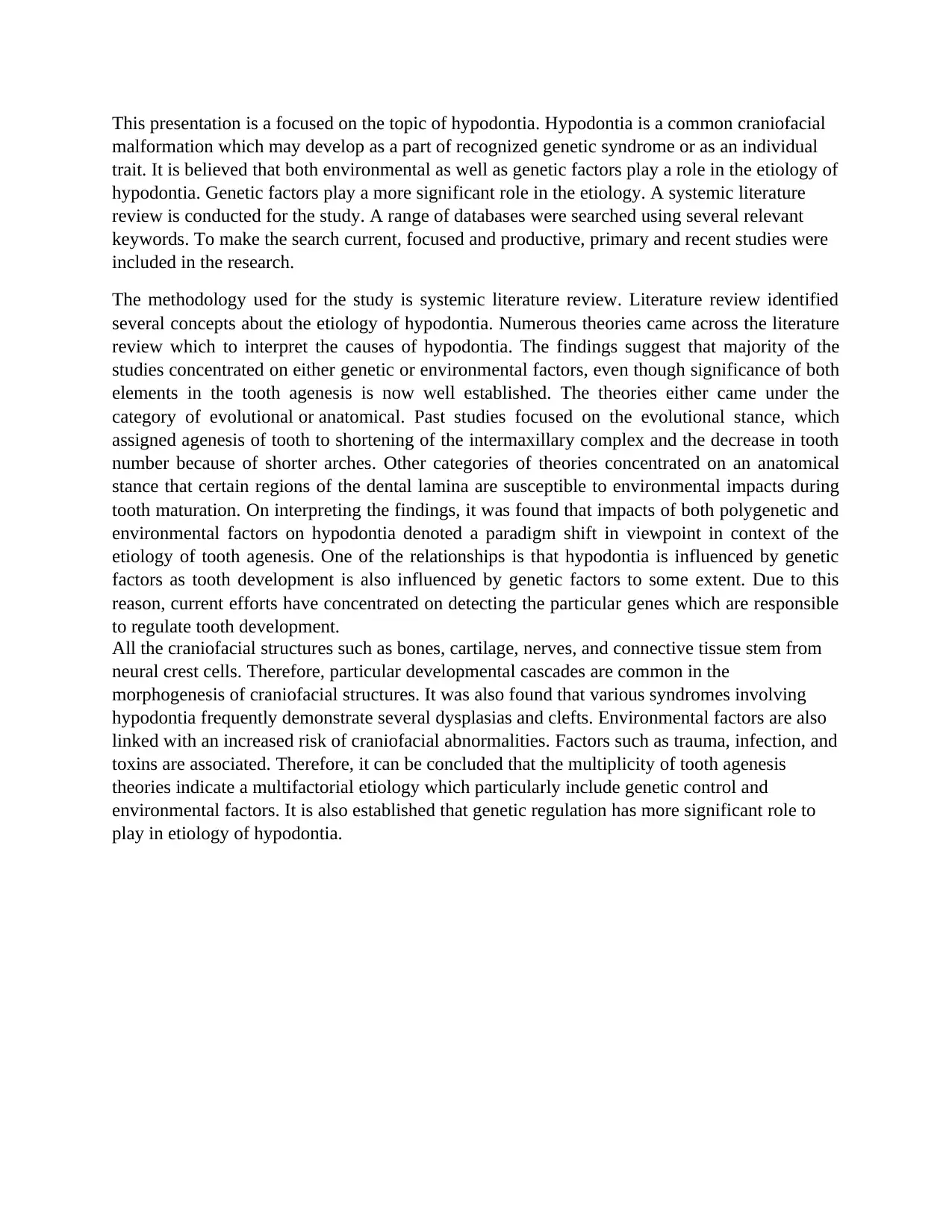Hypodontia: Genetic Etiology and Environmental Factors Presentation
VerifiedAdded on 2023/04/08
|1
|403
|366
Presentation
AI Summary
This presentation provides a detailed overview of hypodontia, a common craniofacial malformation. The presentation explores the genetic and environmental factors that contribute to the etiology of hypodontia, emphasizing the significant role of genetics. It includes a systemic literature ...

This presentation is a focused on the topic of hypodontia. Hypodontia is a common craniofacial
malformation which may develop as a part of recognized genetic syndrome or as an individual
trait. It is believed that both environmental as well as genetic factors play a role in the etiology of
hypodontia. Genetic factors play a more significant role in the etiology. A systemic literature
review is conducted for the study. A range of databases were searched using several relevant
keywords. To make the search current, focused and productive, primary and recent studies were
included in the research.
The methodology used for the study is systemic literature review. Literature review identified
several concepts about the etiology of hypodontia. Numerous theories came across the literature
review which to interpret the causes of hypodontia. The findings suggest that majority of the
studies concentrated on either genetic or environmental factors, even though significance of both
elements in the tooth agenesis is now well established. The theories either came under the
category of evolutional or anatomical. Past studies focused on the evolutional stance, which
assigned agenesis of tooth to shortening of the intermaxillary complex and the decrease in tooth
number because of shorter arches. Other categories of theories concentrated on an anatomical
stance that certain regions of the dental lamina are susceptible to environmental impacts during
tooth maturation. On interpreting the findings, it was found that impacts of both polygenetic and
environmental factors on hypodontia denoted a paradigm shift in viewpoint in context of the
etiology of tooth agenesis. One of the relationships is that hypodontia is influenced by genetic
factors as tooth development is also influenced by genetic factors to some extent. Due to this
reason, current efforts have concentrated on detecting the particular genes which are responsible
to regulate tooth development.
All the craniofacial structures such as bones, cartilage, nerves, and connective tissue stem from
neural crest cells. Therefore, particular developmental cascades are common in the
morphogenesis of craniofacial structures. It was also found that various syndromes involving
hypodontia frequently demonstrate several dysplasias and clefts. Environmental factors are also
linked with an increased risk of craniofacial abnormalities. Factors such as trauma, infection, and
toxins are associated. Therefore, it can be concluded that the multiplicity of tooth agenesis
theories indicate a multifactorial etiology which particularly include genetic control and
environmental factors. It is also established that genetic regulation has more significant role to
play in etiology of hypodontia.
malformation which may develop as a part of recognized genetic syndrome or as an individual
trait. It is believed that both environmental as well as genetic factors play a role in the etiology of
hypodontia. Genetic factors play a more significant role in the etiology. A systemic literature
review is conducted for the study. A range of databases were searched using several relevant
keywords. To make the search current, focused and productive, primary and recent studies were
included in the research.
The methodology used for the study is systemic literature review. Literature review identified
several concepts about the etiology of hypodontia. Numerous theories came across the literature
review which to interpret the causes of hypodontia. The findings suggest that majority of the
studies concentrated on either genetic or environmental factors, even though significance of both
elements in the tooth agenesis is now well established. The theories either came under the
category of evolutional or anatomical. Past studies focused on the evolutional stance, which
assigned agenesis of tooth to shortening of the intermaxillary complex and the decrease in tooth
number because of shorter arches. Other categories of theories concentrated on an anatomical
stance that certain regions of the dental lamina are susceptible to environmental impacts during
tooth maturation. On interpreting the findings, it was found that impacts of both polygenetic and
environmental factors on hypodontia denoted a paradigm shift in viewpoint in context of the
etiology of tooth agenesis. One of the relationships is that hypodontia is influenced by genetic
factors as tooth development is also influenced by genetic factors to some extent. Due to this
reason, current efforts have concentrated on detecting the particular genes which are responsible
to regulate tooth development.
All the craniofacial structures such as bones, cartilage, nerves, and connective tissue stem from
neural crest cells. Therefore, particular developmental cascades are common in the
morphogenesis of craniofacial structures. It was also found that various syndromes involving
hypodontia frequently demonstrate several dysplasias and clefts. Environmental factors are also
linked with an increased risk of craniofacial abnormalities. Factors such as trauma, infection, and
toxins are associated. Therefore, it can be concluded that the multiplicity of tooth agenesis
theories indicate a multifactorial etiology which particularly include genetic control and
environmental factors. It is also established that genetic regulation has more significant role to
play in etiology of hypodontia.
Paraphrase This Document
Need a fresh take? Get an instant paraphrase of this document with our AI Paraphraser
1 out of 1
Your All-in-One AI-Powered Toolkit for Academic Success.
+13062052269
info@desklib.com
Available 24*7 on WhatsApp / Email
![[object Object]](/_next/static/media/star-bottom.7253800d.svg)
Unlock your academic potential
© 2024 | Zucol Services PVT LTD | All rights reserved.
